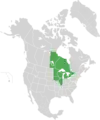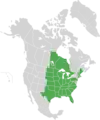Symphyotrichum lanceolatum
Symphyotrichum lanceolatum (formerly Aster lanceolatus and Aster simplex) is a species of flowering plant in the family Asteraceae native to North America. Common names include panicled aster, lance-leaved aster, and white panicled aster. It is a perennial, herbaceous plant that may reach 1.5 meters (5 feet) tall or more, sometimes approaching 2 m (6+1⁄2 ft). The lance-shaped leaves are generally hairless but may feel slightly rough to the touch on the top because of tiny bristles. The flowers grow in clusters and branch in panicles. They have 16–50 white ray florets that are up to 14 millimeters (1⁄2 inch) long and sometimes tinged pink or purple. The flower centers consist of disk florets that begin as yellow and become purple as they mature.
| Symphyotrichum lanceolatum | |
|---|---|
.jpg.webp) | |
| Scientific classification | |
| Kingdom: | Plantae |
| Clade: | Tracheophytes |
| Clade: | Angiosperms |
| Clade: | Eudicots |
| Clade: | Asterids |
| Order: | Asterales |
| Family: | Asteraceae |
| Tribe: | Astereae |
| Subtribe: | Symphyotrichinae |
| Genus: | Symphyotrichum |
| Subgenus: | Symphyotrichum subg. Symphyotrichum |
| Section: | Symphyotrichum sect. Symphyotrichum |
| Species: | S. lanceolatum |
| Binomial name | |
| Symphyotrichum lanceolatum | |
| Subspecies and varieties[2] | |
 | |
| Native distribution of Symphyotrichum lanceolatum by state, province, and territory.[3][4] For infraspecies distributions, see text. | |
| Synonyms | |
|
Basionym
| |
The species occurs in a wide variety of mostly moist and open habitats, including riparian areas (areas between land and a river or stream), meadows, and ditches. Panicled aster has a stout rhizome and can spread to form a clonal colony as well as reproduce by wind-blown seed. Because of its rhizomatic spreading and its production of chemicals that can be detrimental to other plants around it, the species can do damage to ecosystems outside of its native range, as it has in Europe where it has been introduced.
Symphyotrichum lanceolatum is currently divided into subspecies and varieties which have minor differences in appearance and vary in chromosome counts as well as distribution, with some overlap. It is a conservationally secure species whose late-summer and fall appearing flowers play an important role for late-season pollinators and nectar-seeking insects such as bumblebees, wasps, and hoverflies. In addition to being used by indigenous peoples of the Americas for medicinal purposes, it has been cultivated as an ornamental garden plant and used in the cut flower industry.
Description
Panicled aster grows from a rhizome and has a thick, erect stem that can reach 1.5 meters (5 feet) tall or more, sometimes approaching 2 m (6+1⁄2 ft). The leaves are generally hairless but may feel slightly rough to the touch on the top because of tiny bristles. The leaf blades have winged petioles and may sheath the stem at their bases. The largest leaves, near the base of the plant, are up to about 15 centimeters (6 inches) long. Those higher on the stem are smaller, and the lower leaves may have toothed edges.[3]
The inflorescence is usually a large, branching panicled array of many flower heads of varying size. Each flower head has many tiny florets put together into what appear as one. There are 16 to 50 ray florets per head, each measuring 3–14 millimeters (1⁄8–1⁄2 inch) long, in white, sometimes tinged pink or purple. The roughly 20–40 disk florets bloom yellow and turn purple. Each has five lobes that may spread when open.[3]
Chromosomes
Symphyotrichum lanceolatum has a base number of x = 8.[10] Tetraploid, pentaploid, hexaploid, septaploid, and octaploid cytotypes with respective chromosome counts of 32, 40, 48, 56, and 64 have been reported, depending on the infraspecies, as follows:
- S. lanceolatum var. hesperium: 2n = 8x = 64.[4]
- S. lanceolatum var. hirsuticaule: 2n = 4x = 32.[11]
- S. lanceolatum var. interior: 2n = 6x = 48 and 2n = 8x = 64.[12]
- S. lanceolatum var. lanceolatum: 2n = 4x = 32, 2n = 5x = 40, 2n = 6x = 48, 2n = 7x = 56, and 2n = 8x = 64.[13]
- S. lanceolatum var. latifolium: 2n = 8x = 64.[14]
Taxonomy
.jpg.webp)
Symphyotrichum lanceolatum was formerly included in the large genus Aster as Aster lanceolatus. However, this broad circumscription of Aster is polyphyletic and the North American asters are now mostly classified in Symphyotrichum and several other genera.[15] It is classified in the subgenus Symphyotrichum, section Symphyotrichum, subsection Dumosi,[16] one of the "bushy asters and relatives".[10]
Infraspecies
This species may be divided into two subspecies and five varieties, shown here.[3] NatureServe follows this circumscription.[1]
- S. lanceolatum subsp. hesperium
- S. lanceolatum var. hesperium
- S. lanceolatum subsp. lanceolatum
- S. lanceolatum var. hirsuticaule
- S. lanceolatum var. interior
- S. lanceolatum var. lanceolatum
- S. lanceolatum var. latifolium
In the case of the subspecies autonyms, sometimes one or the other will be ignored or treated as taxonomic synonyms, as in the case of Plants of the World Online (POWO), for example, shown here:[2]
- S. lanceolatum subsp. lanceolatum
- S. lanceolatum var. hesperium
- S. lanceolatum var. hirsuticaule
- S. lanceolatum var. interior
- S. lanceolatum var. latifolium
Hybrids
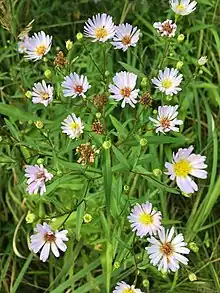
The hybrid of S. lanceolatum var. lanceolatum with S. novi-belgii var. novi-begii, known as Sympyotrichum × salignum, originated in cultivation and is now naturalized in Europe. Hybrids also have been reported with S. boreale, S. laeve, S. lateriflorum, S. puniceum and S. racemosum.[13]
Etymology
Symphyotrichum lanceolatum is commonly known as panicled aster, white panicled aster, and lance-leaved aster.[3] Other common names include tall white aster,[17] eastern line aster, lance-leaf aster, and white-panicle aster.[18]
Along with other asters that bloom in the fall, Symphyotrichum lanceolatum may be called a Michaelmas daisy. Narrow-leaf Michaelmas daisy is also one of its common names.[18] S. lanceolatum var. interior may be called interior white aster,[19] and S. lanceolatum var. latifolium may be called broadleaf panicled aster.[20] S. lanceolatum var. hesperium common names include western line aster, western willow aster, Wooten's aster, and Siskiyou aster.[21] Another species in the family Asteraceae, Eucephalus glabratus, is also commonly known as Siskiyou aster.[22]
Aster comes from the Ancient Greek word ἀστήρ (astḗr), meaning "star," referring to the shape of the flower. The word "aster" was used to describe a star-like flower as early as 1542 in German physician and botanist Leonhart Fuchs' book De historia stirpium commentarii insignes, Latin for Notable Commentaries on the History of Plants. An old common name for Astereae species using the suffix "-wort" is starwort, also spelled star-wort or star wort. An early use of this name can be found in the same work by Fuchs as Sternkraut, translated from German literally as "star herb" (Stern Kraut).[23]
The specific epithet (second part of the binomial name) lanceolatum is a Latin adjective meaning "lance-shaped."[24] The genus name Symphyotrichum is a combining of Ancient Greek words meaning "junction of hair."[25]
Distribution and habitat
Native
Symphyotrichum lanceolatum is native to much of Canada, the United States, and northwestern Mexico.[3][4] In its native range, it occurs in a wide variety of mostly moist and open habitats, including riparian areas, meadows, and ditches. Distribution and habitat vary among the infraspecies.[13][4]
S. lanceolatum var. lanceolatum is widespread in central and northeastern North America. It is absent in the west and southeast. It grows at 0–900 meters (0–2,950 feet) in stream banks, thicket borders, meadows, fields, and ditches.[13]
S. lanceolatum var. hesperium is a widespread western species native to North America in the Northwest Territories, from British Columbia to Quebec; nearly all the contiguous United States west of the Mississippi River, plus Wisconsin; as well as the Mexican states of Baja California, Sonora and Chihuahua. It grows at 10–2,700 m (30–8,860 ft) on the edges of streams in prairies, wet meadows, open slopes of mountainous pine forests, roadside ditches, and can live in calcareous soil.[4]
S. lanceolatum var. hirsuticaule is native to the northwestern Great Lakes region as well as southeast Manitoba in "mucky soils on glacial deposits," and it can be found at 100–300 m (330–980 ft).[11]
S. lanceolatum var. interior is native to streams in lowlands at 10–400 m (30–1,310 ft) in most of the Great Lakes region of North America as well as the central United States.[12]
S. lanceolatum var. latifolium is a very widespread central and eastern species where grows in thickets, deciduous woods borders, stream banks, and ditches at 0–800 m (0–2,620 ft). It is the only variety native to the southeastern United States.[14]
Introduced
Symphyotrichum lanceolatum has been introduced and naturalized in many parts of Europe, from Belgium to Serbia to Latvia, where it occurs in disturbed man-made habitats and riparian areas as an invasive species.[26][27][28] As of 2020, it was not on the European Union's List of invasive alien species of Union concern.[29]
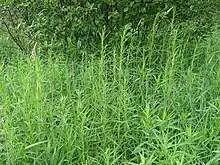
Ecology
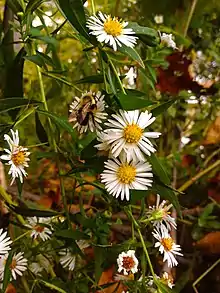
In its native range, Symphyotrichum lanceolatum may be a minor weed in agricultural fields.[30] In addition to dispersal by wind-blown seed, it spreads extensively by rhizomes to create large clonal colonies.[31] Although these clones do not dominate habitats in North America, growing in association with grasses, goldenrods, and other asters,[32] in Europe it is an invasive species that excludes native plants in riparian habitats. This invasiveness has been linked to allelopathic compounds in S. lanceolatum tissue and their effects on native European plants.[26] Viable seed production in Europe seems to be limited, and the species largely spreads there via rhizomes.[28]
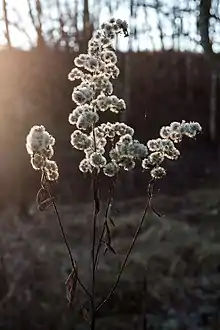
The species is visited by a wide variety of late-season pollinating and nectar-seeking insects, including bees, hoverflies, flies, moths, and wasps.[24] Cross-fertilization is usually required to produce viable seed, and as such, large clones may have low seed production.[33]
Pests and diseases
Several midge species are known to form galls on Symphyotrichum lanceolatum where their larvae can develop, including Rhopalomyia asteriflorae in the flowers or buds resulting in their stunted growth,[34] and Rhopalomyia strobiligemma.[24]
The leaf-blister gall midge Asteromyia paniculata and the fungus Schlerotium asteris have a symbiotic relationship on the leaves in that the fungus gains additional nutrition from the larva and, in turn, gives some shelter to the midge.[34]
Leaf-mining insects known to feed on this species include Sumitrosis inaequalis, Ophiomyia curvipalpis, Phytomyza albiceps, and Microrhopala xerene. Younger instars of gorgone checkerspot caterpillars (Chlosyne gorgone) will feed on S. lanceolatum.[34]
Conservation
NatureServe lists the species Symphyotrichum lanceolatum as a whole as Secure (G5) worldwide; Vulnerable (S3) in Iowa; and, Imperiled (S2) in North Carolina and Newfoundland.[1] S. l. subsp. hesperium, S. l. subsp. lanceolatum, S. l. var. interior, and S. l. var. latifolium are all listed as a Secure Subspecies (T5) globally.[35][36][19][20] NatureServe has no global ranking for S. l. var. hirsuticaule.[37]
In individual states and provinces of the United States and Canada, S. lanceolatum subsp. hesperium is Vulnerable (S3) in Wyoming, and Critically Imperiled (S1) in Texas;[35] S. l. var. interior is Possibly Extirpated (SH) in New York state and Quebec, and Critically Imperiled (S1) in New Jersey;[19] and, S. l. var. latifolium is Vulnerable (S3) in Ontario and Georgia.[20] S. l. var. hirsuticaule has no vulnerable or critical state or province rankings.[37]
Uses
Medicinal
Within its native range, Symphyotrichum lanceolatum has been used by indigenous peoples for a variety of medicinal purposes: S. l. var. hesperium by the Zuni people in the American Southwest for wounds and nosebleed,[38] and S. l. var. lanceolatum by the Iroquois in what is now eastern Canada to treat fever.[39]
Gardening
Symphyotrichum lanceolatum has been cultivated as an ornamental garden plant and used in the cut flower industry.[40] Cultivar 'Edwin Beckett', developed before 1902, has pale violet-blue ray florets that make a flower head which is about 25 millimeters (1 inch) wide.[41] As of July 2021, it was listed in the Royal Horticultural Society Plant Finder with availability at 3–4 nurseries.[42]
Citations
- NatureServe 2021a.
- POWO 2021a.
- Brouillet et al. 2020a.
- Brouillet et al. 2020b.
- POWO 2021e.
- POWO 2021b.
- POWO 2021c.
- POWO 2021d.
- POWO 2021f.
- Semple n.d.
- Brouillet et al. 2020c.
- Brouillet et al. 2020d.
- Brouillet et al. 2020e.
- Brouillet et al. 2020f.
- Semple 2021a.
- Semple 2021b.
- Dickinson et al. 2004.
- GRIN n.d.a.
- NatureServe 2021e.
- NatureServe 2021f.
- GRIN n.d.b.
- CNPS Rare Plant Program 2021.
- Fuchs 1542.
- Wilhelm & Rericha 2017, p. 1101.
- Wilhelm & Rericha 2017, p. 1095.
- Nešić et al. 2016.
- Gudžinskas & Petrulaitis 2016.
- Verloove 2018.
- European Commission 2020.
- Chmielewski & Semple 2001, p. 838.
- Chmielewski & Semple 2001, p. 843.
- Chmielewski & Semple 2001, p. 840.
- Chmielewski & Semple 2001, p. 842.
- Chmielewski & Semple 2001, p. 846.
- NatureServe 2021b.
- NatureServe 2021c.
- NatureServe 2021d.
- Stevenson 1915.
- Rousseau 1945.
- Chmielewski & Semple 2001, p. 839.
- Picton 1999, p. 132.
- Royal Horticultural Society n.d.
References
- Brouillet, L.; Semple, J.C.; Allen, G.A.; Chambers, K.L.; Sundberg, S.D. (6 November 2020a). "Symphyotrichum lanceolatum". Flora of North America (floranorthamerica.org). Point Arena, California: Flora of North America Association. Retrieved 1 February 2021.
- Brouillet, L.; Semple, J.C.; Allen, G.A.; Chambers, K.L.; Sundberg, S.D. (5 November 2020b). "Symphyotrichum lanceolatum var. hesperium". Flora of North America (floranorthamerica.org). Point Arena, California: Flora of North America Association. Retrieved 1 February 2021.
- Brouillet, L.; Semple, J.C.; Allen, G.A.; Chambers, K.L.; Sundberg, S.D. (5 November 2020c). "Symphyotrichum lanceolatum var. hirsuticaule". Flora of North America (floranorthamerica.org). Point Arena, California: Flora of North America Association. Retrieved 1 February 2021.
- Brouillet, L.; Semple, J.C.; Allen, G.A.; Chambers, K.L.; Sundberg, S.D. (5 November 2020d). "Symphyotrichum lanceolatum var. interior". Flora of North America (floranorthamerica.org). Point Arena, California: Flora of North America Association. Retrieved 1 February 2021.
- Brouillet, L.; Semple, J.C.; Allen, G.A.; Chambers, K.L.; Sundberg, S.D. (5 November 2020e). "Symphyotrichum lanceolatum var. lanceolatum". Flora of North America (floranorthamerica.org). Point Arena, California: Flora of North America Association. Retrieved 1 February 2021.
- Brouillet, L.; Semple, J.C.; Allen, G.A.; Chambers, K.L.; Sundberg, S.D. (5 November 2020f). "Symphyotrichum lanceolatum var. latifolium". Flora of North America (floranorthamerica.org). Point Arena, California: Flora of North America Association. Retrieved 1 February 2021.
- Chmielewski, J.G.; Semple, J.C. (2001). "The biology of Canadian weeds. 113. Symphyotrichum lanceolatum (Willd.) Nesom [Aster lanceolatus Willd.] and S. lateriflorum (L.) Löve & Löve [Aster lateriflorus (L.) Britt.]". Canadian Journal of Plant Science. Ottawa: Canadian Science Publishing. 81 (4): 829–849. doi:10.4141/P00-056. Retrieved 28 December 2020.
- CNPS Rare Plant Program (2021). "Eucephalus glabratus (Greene) Greene". California Native Plant Society (www.cnps.org). Sacramento: California Native Plant Society. Retrieved 3 February 2021.
- Dickinson, T.; Metsger, D.; Bull, J.; Dickinson, R. (2004). The ROM Field Guide to Wildflowers of Ontario. Toronto: Royal Ontario Museum. p. 190. ISBN 978-0-7710-7652-7.
- European Commission (2020). "List of Invasive Alien Species of Union concern". ec.europa.eu. European Union. Retrieved 1 February 2021.
- Fuchs, L. (1542). De historia stirpium commentarii insignes (in Latin). Illustrated by Meyer, A.; Füllmaurer, H.; and Speckle, V.R. Basel, Switzerland: In officina Isingriniana. p. 133. Retrieved 3 January 2021 – via Biodiversity Heritage Library.
- GRIN (n.d.a). "Symphyotrichum lanceolatum (Willd.) G. L. Nesom". Germplasm Resources Information Network (GRIN). Agricultural Research Service (ARS), United States Department of Agriculture (USDA). Retrieved 2 February 2021.
- GRIN (n.d.b). "Symphyotrichum lanceolatum (Willd.) G. L. Nesom subsp. hesperium (A. Gray) G. L. Nesom". Germplasm Resources Information Network (GRIN). Agricultural Research Service (ARS), United States Department of Agriculture (USDA). Retrieved 2 February 2021.
- Gudžinskas, Z.; Petrulaitis, L. (2016). "New alien plant species recorded in the southern regions of Latvia". Botanica Lithuanica. 22 (2): 153–160. doi:10.1515/botlit-2016-0016. S2CID 90264607. Retrieved 1 February 2021 – via Sciendo.
- NatureServe (8 January 2021a). "Symphyotrichum lanceolatum - Panicled Aster". explorer.natureserve.org. Arlington, Virginia. Retrieved 2 February 2021.
- NatureServe (8 January 2021b). "Symphyotrichum lanceolatum ssp. hesperium - Siskiyou Aster". explorer.natureserve.org. Arlington, Virginia. Retrieved 2 February 2021.
- NatureServe (8 January 2021c). "Symphyotrichum lanceolatum ssp. lanceolatum - Panicled Aster". explorer.natureserve.org. Arlington, Virginia. Retrieved 2 February 2021.
- NatureServe (8 January 2021d). "Symphyotrichum lanceolatum var. hirsuticaule - Panicled Aster". explorer.natureserve.org. Arlington, Virginia. Retrieved 2 February 2021.
- NatureServe (8 January 2021e). "Symphyotrichum lanceolatum var. interior - Interior White Aster". explorer.natureserve.org. Arlington, Virginia. Retrieved 2 February 2021.
- NatureServe (8 January 2021f). "Symphyotrichum lanceolatum var. latifolium - Broadleaf Panicled Aster". explorer.natureserve.org. Arlington, Virginia. Retrieved 2 February 2021.
- Nešić, M.; Obratov-Petković, D.; Skočajić, D.; Bjedov, I.; Đukić, M.; Đunisijević-Bojović, D. (2016). "Allelopathic potential of the invasive species Aster lanceolatus Willd". Periodicum Biologorum. 118 (1): 1–7. doi:10.18054/pb.2016.118.1.2816. Retrieved 1 February 2021 – via Hrčak: Portal of Croatian Scientific and Professional Journals.
- Picton, P. (1999). The gardener's guide to growing asters. Portland, Oregon: Timber Press, Inc. ISBN 0-88192-473-3. OCLC 715820196.
- POWO (2021a). "Symphyotrichum lanceolatum (Willd.) G.L.Nesom". Plants of the World Online. Royal Botanic Gardens, Kew. Retrieved 27 July 2021.
- POWO (2021b). "Symphyotrichum lanceolatum var. hesperium (A.Gray) G.L.Nesom". Plants of the World Online. Royal Botanic Gardens, Kew. Retrieved 27 July 2021.
- POWO (2021c). "Symphyotrichum lanceolatum var. hirsuticaule (Semple & Chmiel.) G.L.Nesom". Plants of the World Online. Royal Botanic Gardens, Kew. Retrieved 27 July 2021.
- POWO (2021d). "Symphyotrichum lanceolatum var. interior (Wiegand) G.L.Nesom". Plants of the World Online. Royal Botanic Gardens, Kew. Retrieved 27 July 2021.
- POWO (2021e). "Symphyotrichum lanceolatum subsp. lanceolatum". Plants of the World Online. Royal Botanic Gardens, Kew. Retrieved 27 July 2021.
- POWO (2021f). "Symphyotrichum lanceolatum var. latifolium (Semple & Chmiel.) G.L.Nesom". Plants of the World Online. Royal Botanic Gardens, Kew. Retrieved 27 July 2021.
- Rousseau, J. (1945). "Le Folklore Botanique De Caughnawaga". Contributions de l'Institut botanique l'Université de Montréal. 55: 65. Retrieved 1 July 2021 – via abstract at Native American Ethnobotany DB (naeb.brit.org).
- Royal Horticultural Society (n.d.). "RHS Plant Finder - Symphyotrichum lanceolatum 'Edwin Beckett'". www.rhs.org.uk. London: Royal Horticultural Society. Retrieved 27 July 2021.
- Semple, J.C. (n.d.). "Symphyotrichum subsect. Dumosi: Bushy Asters and Relatives". www.uwaterloo.ca. Ontario: University of Waterloo. Archived from the original on 27 May 2021. Retrieved 27 May 2021.
- Semple, J.C. (27 April 2021a). "An overview of "asters" and the Tribe Astereae". www.uwaterloo.ca. Ontario: University of Waterloo. Archived from the original on 27 May 2021. Retrieved 22 June 2021.
- Semple, J.C. (17 May 2021b). "Classification of Symphyotrichum in the restricted sense". www.uwaterloo.ca. Ontario: University of Waterloo. Archived from the original on 27 May 2021. Retrieved 7 July 2021.
- Stevenson, M.C. (1915). "Ethnobotany of the Zuñi Indians". Smithsonian Institution-Bureau of American Ethnology (SI-BAE) Annual Report. Washington: U.S. Government Printing Office. 30: 43. Retrieved 27 July 2021 – via Biodiversity Heritage Library.
- Verloove, F. (26 February 2018). "Symphyotrichum lanceolatum". Manual of the Alien Plants of Belgium (alienplantsbelgium.be). Belgium: Meise Botanic Garden. Retrieved 1 February 2021.
- Wilhelm, G.; Rericha, L. (2017). Flora of the Chicago Region: A Floristic and Ecological Synthesis. Illustrated by Lowther, M.M. Indianapolis: Indiana Academy of Science. ISBN 978-1883362157. OCLC 983207050.
Further reading
- Chmielewski, J.G.; Semple, J.C. (July 1983). "The cytogeography of Aster lanceolatus. III. Cytoecology in southern Ontario". Canadian Journal of Botany. Ottawa, Ontario: Canadian Science Publishing. 61 (7): 1879–1886. doi:10.1139/b83-199.
- Schmid, B.; Bazzaz, F.A.; Weiner, J. (November 1995). "Size dependency of sexual reproduction and of clonal growth in two perennial plants". Canadian Journal of Botany. Ottawa, Ontario: Canadian Science Publishing. 73 (11): 1831–1837. doi:10.1139/b95-194.
- Semple, J.C. (February 1979). "The cytogeography of Aster lanceolatus (synonyms A. simplex and A. paniculatus) in Ontario with additional counts from populations in the United States". Canadian Journal of Botany. Ottawa, Ontario: Canadian Science Publishing. 57 (4): 397–402. doi:10.1139/b79-051.
- Semple, J.C. (5 May 2021). "Symphyotrichum lanceolatum". www.uwaterloo.ca. Ontario: University of Waterloo. Archived from the original on 27 July 2021.
- Semple, J.C.; Brammall, R.A. (November 1982). "Wild Aster lanceolatus × lateriflorus hybrids in Ontario and comments on the origin of A. ontarionis (Compositae–Astereae)". Canadian Journal of Botany. Ottawa, Ontario: Canadian Science Publishing. 60 (10): 1895–1906. doi:10.1139/b82-237.
- Semple, J.C.; Chmielewski, J.G. (May 1987). "Revision of the Aster lanceolatus complex, including A. simplex and A. hesperius (Compositae: Astereae): a multivariate morphometric study". Canadian Journal of Botany. Ottawa, Ontario: Canadian Science Publishing. 65 (5): 1047–1062. doi:10.1139/b87-146.
- Semple, J.C.; Chmielewski, J.G.; Sankara Rao, K.; Allen, G.A. (February 1983). "The cytogeography of Aster lanceolatus. II. A preliminary survey of the range including A. hesperius". Canadian Journal of Botany. Ottawa, Ontario: Canadian Science Publishing. 61 (2): 434–441. doi:10.1139/b83-050.
- TWC Staff (2021). "Symphyotrichum lanceolatum". Lady Bird Johnson Wildflower Center (www.wildflower.org). University of Texas at Austin.



